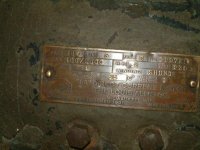pgopinath
Plastic
- Joined
- Apr 28, 2008
- Location
- Minneapolis
First post and an absolute beginner in restoring machines.
I will be picking up an older Oliver 25 patternmaker lathe. The headstock spindle is directly driven by a 2HP 230VDC/8AMP motor.

The motor is supplied from a outboard transformer/rectifier that converts 115VAC to 230VDC. This rectifier unit is a huge 200lb unit that is about 18"x30"x18".

The speed control is through a circular (copper wound?) rheostat that goes 400rpm to 2000rpm.


I am hoping to replace the existing drive electrics (rectifier, rheostat) with a solid state DC drive that would give me speed control from close to zero rpm to 2000 rpm. Ideally, the solid state drive would take 115VAC/230VAC and output the variable DC to the motor.
Even more ideally, I would like to find a step-pulley headstock for this and convert it to a 3phase VFD driven motor but I don't think I will be that lucky. But if someone has any pointers I will take them.
Can someone give me some guidance on sources for the DC drive I am looking for or for alternate ways of doing what I am trying to do?
Thanks in advance
Prabha
I will be picking up an older Oliver 25 patternmaker lathe. The headstock spindle is directly driven by a 2HP 230VDC/8AMP motor.

The motor is supplied from a outboard transformer/rectifier that converts 115VAC to 230VDC. This rectifier unit is a huge 200lb unit that is about 18"x30"x18".

The speed control is through a circular (copper wound?) rheostat that goes 400rpm to 2000rpm.


I am hoping to replace the existing drive electrics (rectifier, rheostat) with a solid state DC drive that would give me speed control from close to zero rpm to 2000 rpm. Ideally, the solid state drive would take 115VAC/230VAC and output the variable DC to the motor.
Even more ideally, I would like to find a step-pulley headstock for this and convert it to a 3phase VFD driven motor but I don't think I will be that lucky. But if someone has any pointers I will take them.
Can someone give me some guidance on sources for the DC drive I am looking for or for alternate ways of doing what I am trying to do?
Thanks in advance
Prabha

